 1. A Child’s Life & The Diary of a Teenage Girl by Phoebe Gloeckner
1. A Child’s Life & The Diary of a Teenage Girl by Phoebe Gloeckner
Gloeckner’s semi-autobiographical works include themes of coming of age and sexual awakening, and contain references to sex, drugs, and STIs. In 2004 A Child’s Life was removed from public library shelves in Stockton, CA after a local parent reproduced images from it and leafleted the community with them in protest of what she considered unacceptable material. Stockton’s mayor had the book removed despite objection from the library director; in response, CBLDF joined the National Coalition Against Censorship and the American Library Association to create guidelines for librarians about handling graphic novels intended for adult audiences.
In 2015, CBLDF was involved in a confidential challenge against The Diary of a Teenage Girl over its sexual content, and our efforts kept the book on shelves.
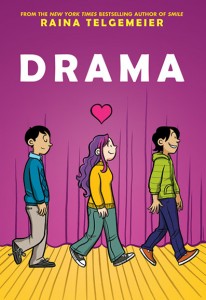 2. Drama by Raina Telgemeier
2. Drama by Raina Telgemeier
This graphic novel about the joys and tribulations of a middle school drama troupe received universal critical praise upon its publication in 2012. Due to the depiction of a chaste on-stage kiss between two boys, however, it has been banned from two schools that we know of, both in Texas: Chapel Hill Elementary School in Mount Pleasant and Kirbyville Junior High in Kirbyville.
- Case Study: Drama
- Comics on Texas ACLU List of 2015-16 School Bans and Challenges
- Adding Drama to Your Library or Classroom Collection
- Using Graphic Novels in Education: Drama
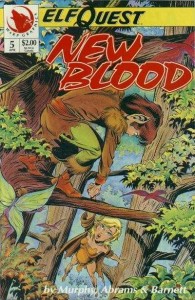 3. Elfquest: New Blood #5-6 by Wendy Pini and Richard Pini
3. Elfquest: New Blood #5-6 by Wendy Pini and Richard Pini
Wendy Pini and her husband Richard launched Elfquest in 1978, and it has since become one of the longest-running independent comics series. The fantasy series features a diverse cast of characters and frequently addresses contemporary social issues through the stories and illustrations. In 1999, CBLDF came to the aid of a West Virginia social worker and comic collector who was arrested and charged with distributing obscene materials to a minor after he sold a neighbor boy two issues of Elfquest that happen to include scenes of childbirth. The comics came nowhere near failing the Miller test for obscenity, so CBLDF legal counsel Burton Joseph was able to get the charges dismissed.
Elfquest also was among the books seized in the 1986 police raid of Friendly Frank’s comic shop, which led to the founding of CBLDF. Ultimately it was not included in the charges filed against store manager Michael Correa, however.
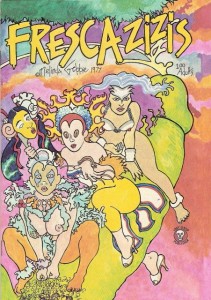 4. Fresca Zizis by Melinda Gebbie
4. Fresca Zizis by Melinda Gebbie
Gebbie’s first solo work, published in 1977, contains brightly colored, dreamy, and explicit images that would eventually catch the eye of UK censors when Knockabout Comics imported 400 copies of the book in 1985. The books were seized by UK customs for pornographic images, and despite Gebbie’s eloquent defense of the book during the subsequent obscenity trial, British authorities ruled that the copies should be confiscated and burned. Possession of the comic remains a crime in the UK today.
- Women Who Changed Free Expression: Banned/Challenged and Pre-Code
- Melinda Gebbie Discusses Lost Girls, Censorship at Edinburgh Book Fest
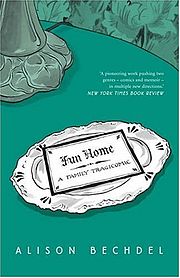 5. Fun Home: A Family Tragicomic by Alison Bechdel
5. Fun Home: A Family Tragicomic by Alison Bechdel
Fun Home is a graphic novel memoir of the author’s childhood, particularly focused on her relationship with her closeted gay father Bruce. As Alison grows older and realizes that she is a lesbian, she and Bruce are both forced to confront how his repression may have affected her own self-image and the way that she dealt with her sexuality.
Fun Home has weathered multiple challenges over the years, including at least three at the post-secondary level — a rare feat for any book.
 6. Lonely Nights Comics by Dori Seda
6. Lonely Nights Comics by Dori Seda
Dori Seda’s work depicts sexuality in a way that emphasizes feminine pleasure, power, and above all else, agency. These qualities, in the context of her irreverent and explicit drawings, contributed to her 1986 solo title Lonely Nights Comics being banned in the UK.
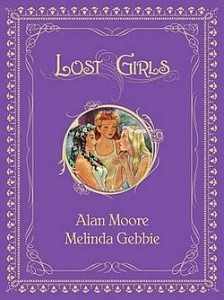 7. Lost Girls by Alan Moore and Melinda Gebbie
7. Lost Girls by Alan Moore and Melinda Gebbie
Gebbie’s collaboration with husband Alan Moore sought to create a piece of literate erotica that focused on three central characters: Dorothy Gale (The Wizard of Oz), Wendy Darling (Peter Pan), and Alice Fairchild (Alice in Wonderland). Gebbie and Moore set their story against tumultuous events contemporary with the adult versions of the characters, including the release of Igor Stravinsky’s The Rite of Spring, the assassination of Archduke Franz Ferdinand, and the start of World War I.
Many expected that Lost Girls would meet with immediate controversy upon its release, but the book has actually met with little resistance in the United States. While some retailers refuse to carry the book, and it has met resistance in foreign markets (most notably, the UK and New Zealand), Gebbie’s sensitive, colorful, and painterly artwork can be credited in no small part for keeping the work from being labeled obscene.
- Women Who Changed Free Expression: Banned/Challenged and Pre-Code
- New Zealand Library Refuses to Carry Lost Girls
- Melinda Gebbie Discusses Lost Girls, Censorship at Edinburgh Book Fest
- Lost Girls Rated 18+ by New Zealand Government Censors
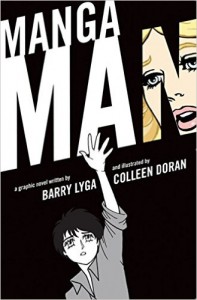 8. Mangaman by Barry Lyga and Colleen Doran
8. Mangaman by Barry Lyga and Colleen Doran
Mangaman tells the story of Ryoko, a manga character who falls through a dimensional rift into a real-world American high school. In the clever metanarrative, Ryoko has trouble fitting in at his new school because he involuntarily brought with him various manga conventions: heart eyes when he develops a crush on the beautiful Marissa Montaigne, speed lines when he moves fast, and perhaps most embarrassing of all, pixelated genitals–an allusion to Article 175 of Japan’s Criminal Code. Despite the fact that Ryoko’s nudity is already ironically censored, the parent of a high school student in Issaquah, WA wanted the book removed from school library shelves last year. A review committee decided the challenge was without merit, and the book remains in the library.
- Washington Parent Objects to Pixelated Genitals in Mangaman
- Mangaman Retained After Challenge in Washington School
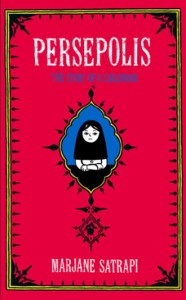 9. Persepolis: The Story of a Childhood by Marjane Satrapi
9. Persepolis: The Story of a Childhood by Marjane Satrapi
Satrapi’s graphic memoir of growing up during the Iranian Revolution has received international acclaim since its initial publication in French, but has also faced multiple challenges in U.S. schools. Complainants most often cite images of torture as the reason for a challenge–as in the notorious 2013 case in Chicago Public Schools–but in at least a few instances the book has come under scrutiny due to Islamophobia alone.
- Case Study: Persepolis
- Adding Persepolis to Your Library or Classroom Collection
- Using Graphic Novels in Education: Persepolis
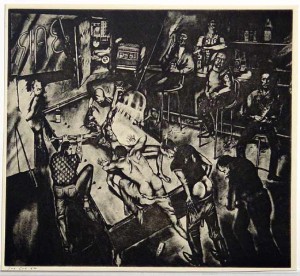 10. “Bedford Rape 1984” (AKA “Rape of Rosa Velez”) by Sue Coe
10. “Bedford Rape 1984” (AKA “Rape of Rosa Velez”) by Sue Coe
This print, which depicts a real incident in which a woman was raped by four men in a bar while 20 others looked on, was originally commissioned for an assignment in Boston Magazine. The publication cropped the final image, however, removing much of the artwork’s impact in doing so. In 1984, British censors shut down a portion of an exhibition at Ferens Gallery in the UK for displaying the piece.
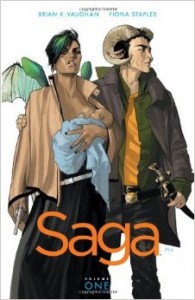 11. Saga (series) by Brian K. Vaughan and Fiona Staples
11. Saga (series) by Brian K. Vaughan and Fiona Staples
The epic sci-fi adventure has not only become one of the bestselling and most critically acclaimed comic series since its debut in March 2012, but also one of the most controversial, holding the sixth spot on the ALA’s 2014 Top Ten List of Frequently Challenged Books. The first volume was challenged in an unidentified public library in Oregon due to sexually explicit content, but the library opted to retain the book on shelves.
 12. Stuck in the Middle: Seventeen Comics from an Unpleasant Age edited by Ariel Schrag
12. Stuck in the Middle: Seventeen Comics from an Unpleasant Age edited by Ariel Schrag
Stuck in the Middle includes seventeen short comics about middle school from acclaimed graphic novelists including Daniel Clowes, Dash Shaw, Gabrielle Bell, Lauren Weinstein, and more. It has been challenged multiple times in schools due to language, sexual content, and drug references. The most recent challenge came just last week in Del City, OK, where the mother of a middle school student called it “trash” and two different local news stations issued egregiously biased reports misrepresenting the book and graphic novels in general. The Mid-Del School District is observing its challenge policy and forming a review committee to decide the book’s fate.
- Case Study: Stuck In The Middle
- Using Graphic Novels in Education: Stuck in the Middle
- Stuck in the Middle Challenged in Oklahoma School
 13. This One Summer by Jillian Tamaki and Mariko Tamaki
13. This One Summer by Jillian Tamaki and Mariko Tamaki
This One Summer is a touching coming-of age story that focuses on Rose and Windy, two long-time friends just entering adolescence. The story focuses on Rose in particular as she navigates her changing relationship with Windy, observes the relationships among local teens, and begins to recognize the strife in her parents’ own relationship. The book received a Caldecott Honor in 2014–the first graphic novel to do so–but the honor also came with some challenges from parents, teachers, and librarians who expect only squeaky-clean picture books in that category.
- Case Study: This One Summer
- Adding This One Summer to Your Library or Classroom Collection
- Using Graphic Novels in Education: This One Summer
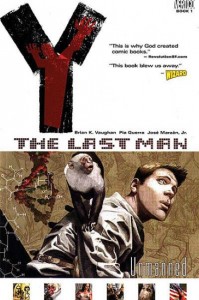 14. Y: The Last Man by Brian K. Vaughan and Pia Guerra
14. Y: The Last Man by Brian K. Vaughan and Pia Guerra
The post-apocalyptic series follows the story of amateur escape artist Yorick Brown and his pet monkey Ampersand, the last males on earth after a mysterious plague wipes out the males of every species, including humans. During ensuing chaos, Yorick must defend himself against terrorist factions, military groups, and the new politics of a world of women who want to capture him.
In June 2015 the first volume of Y: The Last Man was one of four graphic novels that a 20-year-old college student and her parents said should be “eradicated from the system” at Crafton Hills College in Yucaipa, California. The school stood by Associate Professor Ryan Bartlett and his longtime graphic novel course, and even decided not to require a disclaimer on the syllabus after CBLDF joined with NCAC to send a letter in opposition to the plan.
- Case Study: Y: The Last Man
Help support CBLDF’s important First Amendment work in 2017 by visiting the Rewards Zone, making a donation, or becoming a member of CBLDF!
Contributing Editor Maren Williams is a reference librarian who enjoys free speech and rescue dogs.